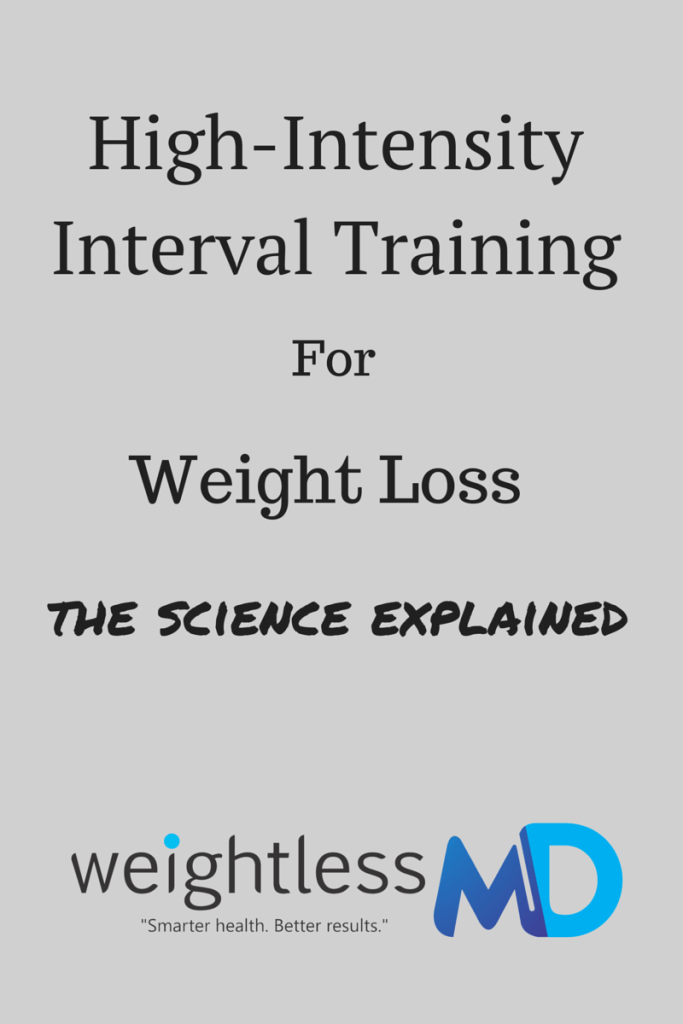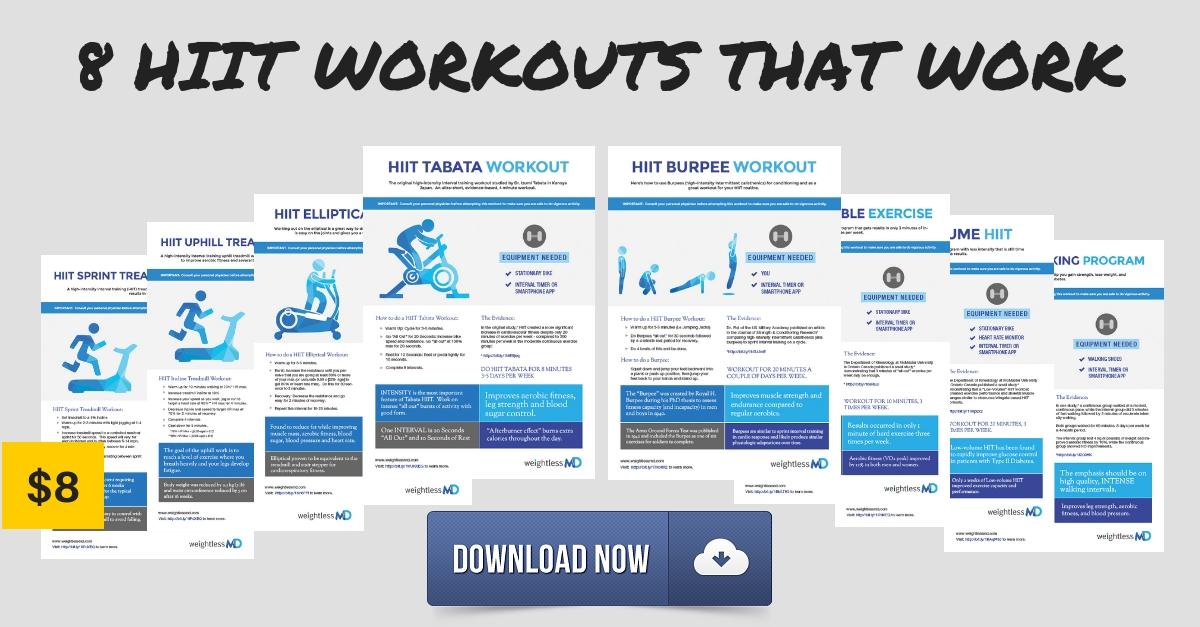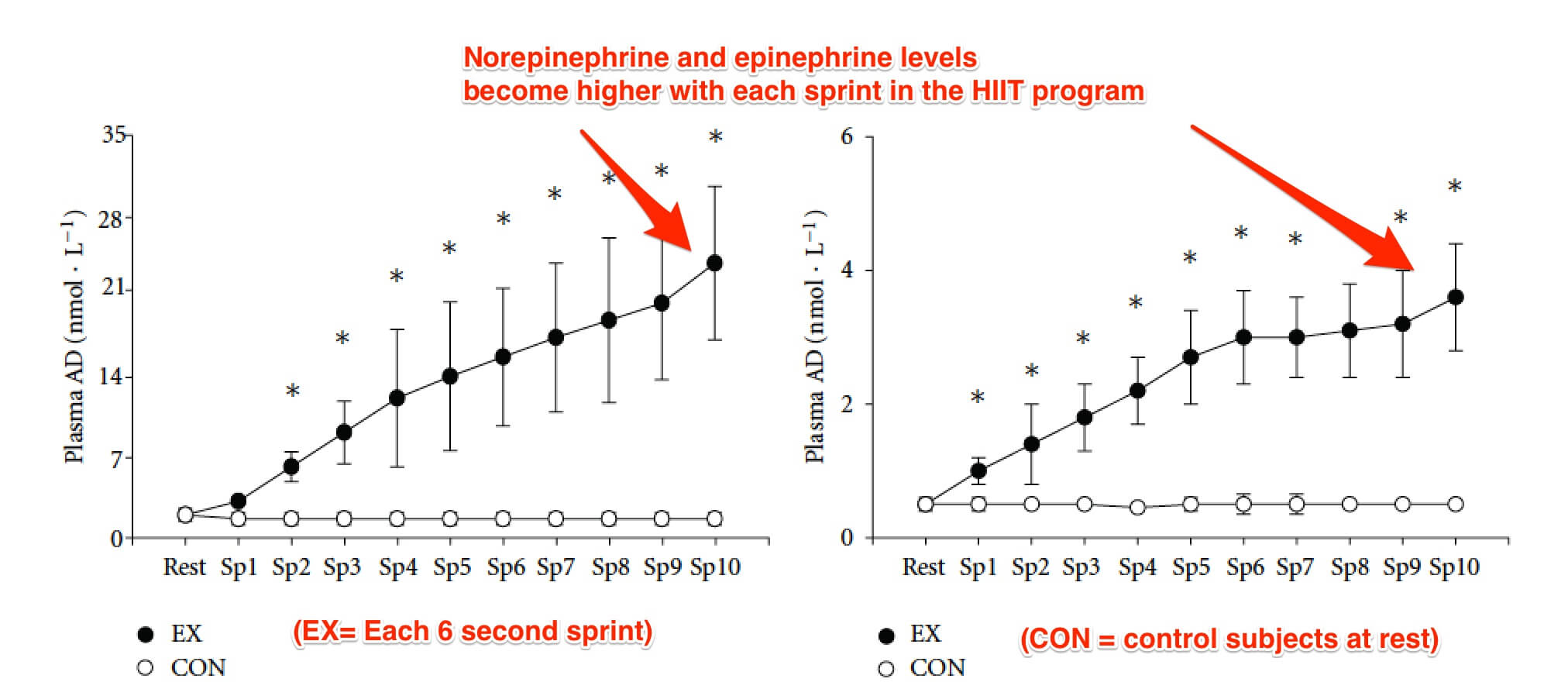My wife got ripped this year.
She was motivated by her diagnosis of pre-diabetes and began a quest to lose weight and build muscle.
As a busy mom, she found quick workout programs.
Initially, the 10-minute trainer by Tony Horton and later the blockbuster, super-hyped-up T25 by Shaun T.
T25 brought her up to 25 minutes a day of exercise.
I was skeptical of her approach.
As a physician who studied weight loss, I knew she would need at least 6o minutes of exercise most days of the week.
But she got results. Her weight dropped and her waistline thinned out. She felt stronger and it showed.
How could this be? Only 10-25 minutes of working out most days of the week and my wife got results.
And, not to forget, her blood sugars normalized and the pre-diabetes went away.
The scientist in me needed answers . . . so I dug into the literature and found some.
Does High Intensity Interval Training (HIIT) really lead to weight loss?
Absolutely.
In fact, the study that pertains most to my wife is from the International Journal of Obesity (1).
They looked at high-intensity interval training (HIIT) in 45 women.
These women were young (around 20 years old), healthy and NOT fat (average BMI of 23).
The purpose of this study was to compare standard exercise versus HIIT on subcutaneous fat (fat just beneath your skin) and abdominal fat (fat in your gut).
They compared a standard exercise routine to HIIT with cycling.
The standard group cycled at a modest pace for 40 minutes.
A rather dull workout.
The HIIT program used a routine of 8 seconds of sprinting on the bike at max effort followed by 12 seconds of slow pedaling. They did this interval for 20 minutes, 3 times per week.
I want to emphasize that participants only worked out 3 times per week for the 15 weeks.
This means the HIIT group only worked out 60 minutes per week.
The results showed that both groups burned the same amount of energy, despite the HIIT group working out in 1/2 the time!
In regard to fat loss, the HIIT group lost fat, but the standard group (40 minutes of monotonous pedaling) gained fat!
The HIIT group lost on average about 2.5 kg (5.5 pounds) of fat in 15 weeks.
The results also showed that the “fattest” participants had the best results.
The HIIT group also lost a significant amount of abdominal fat, about 0.15 kg (1/3rd of a pound). The standard group GAINED abdominal fat.
The HIIT group also had improved insulin sensitivity, with a 31% decrease in fasting insulin concentrations compared to 9% in the standard group.
In summary, this small study shows that women using HIIT on a cycle for 20 minutes, 3 times per week during this 15 week period lost more abdominal fat, subcutaneous fat and improved their insulin sensitivity more than the standard 40 minutes of pedaling a bike.
Better results in half the time.
Another study out of the journal Metabolism compared a 15 week HIIT program with cycling versus a 20 week endurance program (2).
The HIIT program used 1/2 as much energy expenditure, though had significantly better improvements in subcutaneous fat based on skin fold measurements.
Improvements in half the energy output!
HIIT is more strenuous and one could argue that some may not be healthy enough to handle this.
However, if you think you are too old or out of shape, think again.
A study form the European Journal of Endocrinology, however, looked at sedentary, middle aged men with Type II Diabetes Mellitus (3).
Let me repeat . . . sedentary . . . middle aged . . . men.
After 8 weeks of HIIT, abdominal fat had decreased by 44% in this group.
Here is a summary of studies completed that measure HIIT effect on subcutaneous and abdominal fat.
Other studies that were shorter than 8 weeks have been completed, but show less compelling results. This suggests you need to be consistent for at least 2 months to get weight loss.
So , researchers have studies a more practical “low-volume” HIIT.
Does Low-Volume HIIT help with weight loss?
Most of the research uses an intense cycling routine. that may not may not be practical for some.
Going “all out” may not be practical for some.
Researchers began testing a way to use a softer approach to this exercise.
Low-volume HIIT
This is “HIIT-lite.”
Low-volume HIIT requires less overall workload, but appears to get results.
There are fewer studies, so it is difficult to determine how beneficial low-volume HIIT could be, however, one study from the journal Medicine and Science in Sports and Exercise found similar muscle changes in middle-aged adults using low-volume HIIT (4).
They performed 6 training sessions over a 2 week period. Each session involved cycling for 1 minute at 60% of max effort followed by 1 minute of rest. They did 10 bouts 3 times per week for 2 weeks. Muscle biopsies of the thighs before and after showed muscle adaptations and improvements in insulin sensitivity.
Low-volume HIIT may be a good way for those middle aged or with chronic disease to be able to participate in HIIT and similar results to standard exercise.
How could HIIT possibly lead to weight loss? Is it biologically plausible?
There are several ways HIIT could lead to improvement in fat loss:
#1 HIIT causes secretion of hormones epinephrine, norepinephrine and growth hormone
Research has found the stress hormones epinephrine and norepinephrine along with growth hormone are secreted after a HIIT exercise program. This may help to mobilize fat stores to be burned (5, 6, 7, 8).
This figure from the Journal of Obesity shows with each sprint in a HIIT program, there was more and more release of norepinephrine and epinephrine (9).
While HIIT creates a robust catecholamine release (epinephrine and norepinephrine) . . . regular aerobic exercise causes a small increase in epinephrine and norepinephrine release (10).
Why do we care about epinephrine and norepinephrine?
These stress hormones are known to drive lipolysis . . . which is fat release from the tissues such as your abdomen, thighs, glutes, and arms.
Epinephrine in particular drives release of fat from muscle and subcutaneous fat (the fat beneath your skin) (11).
These hormones could be a likely reason behind the abdominal fat improvement in HIIT.
In fact, there are more adrenalin receptors in the abdomen than the subcutaneous fat, suggesting that HIIT may be particularly good at getting rid of abdominal fat (12).
Growth hormone was also found to be elevated by HIIT (13, 14 ).
#2 HIIT improves insulin levels
HIIT seems to also improve insulin sensitivity, which not only would help diabetics but may have a role in fat loss.
Increased weight from increased fat on the body leads to insulin resistance.
Insulin is an energy hormone that is secreted from the pancreas in response to elevated blood sugar. The insulin is the signal to put sugar into the tissues such as muscle.
Imagine insulin being the key that opens the door into the muscle cell to allow blood sugar to get into the cell to be used as an energy source. Insulin resistance is like the door key jamming, or not fitting into some of the doors. If the insulin key cannot open all the doors, the blood sugar stays high and more insulin is released. Eventually the pancreas simply burns out from trying to keep up and release enough insulin. This is what happens in type 2 diabetes.
So, HIIT has been found to help make the muscle cell more sensitive to insulin. Effectively, HIIT exercise fixes the door locks so the insulin key does not get jammed.
Now, if all the doors are working properly, the pancreas does not need to secrete as much insulin.
What does less insulin mean?
Insulin being an energy hormone is also the key to let fat into the cell. Insulin signals fat to be stored and not used as energy.
So, if you have less insulin you have less signal to store fat.
HIIT studies have shown a 23% to 58% improvement in insulin sensitivity. In those without diabetics improvements range from 23% to 33% (15, 16, 17).
For those with diabetes, improvements in insulin sensitivity of 46-58% were found (18, 3)
This supports the possibility that HIIT could help prevent diabetes as well as play a serious role in treatment.
#3 Muscle adapts quickly to HIIT exercises and becomes more efficient at burning energy
Muscle biopsies after bouts of HIIT have shown that even within a couple of weeks of working out the muscle changes and adapts to become more efficient at burning energy and fat. This is thought to occur by increased proteins in the cell organelle called mitochondria that allow for more fatty acid oxidation or fat breakdown. Also, HIIT seems to cause an increase in enzymes that help breakdown glucose for energy (9).
#4 HIIT may help suppress appetite
Nesfatin-1 is a molecule found in the brain hypothalamus that has been found to help regulate hunger (20). Elevated levels of nesfatin-1 in the brain increases the sense of fullness and may help with weight loss. A recent study showed that HIIT causes a significant increase in nesfatin-1 levels in overweight and sedentary men. This effect was not found in moderate continuous exercise. This suggests that HIIT may increase nesfatin-1 up to a week after training leading to appetite suppression (19).
In summary:
High-intensity interval training is a viable way to improve fat loss, especially in the abdomen in less time than typical continuous low to moderate intensity programs.
Studies have found benefits in weight loss, fat loss, cardiorespiratory fitness, insulin sensitivity in very short workouts. There is also plausible biological mechanisms such as release of adrenaline hormones, growth hormone, improvement in insulin sensitivity, improvements in muscle adaptation such as more efficient and robust mitochondria to break down fat as well as an increase in nesfatin-1 levels associated with appetite suppression.
This is especially exciting if you are at all like myself and have less time to work out. High-intensity interval training may help solve this time crunch.
Related:
- One Weight Lose Benefit of HIIT: Appetite Suppression
- 4-minute Tabata HIIT Workout
- High-Intensity Interval Training (HIIT): Elliptical Workout Routine
- Burpee Workout for High-Intensity Interval Training (HIIT)
- An Interval Walking Program: To lose weight, get strong and beat diabetes
The Evidence:
- Trap et al. The effects of high-intensity intermittent exercise training on fat loss and fasting insulin levels of young women. International Journal of Obesity, 2008.
- Tremblay, et al. Impact of exercise intensity on body fatness and skeletal muscle metabolism. Metabolism, 1994.
- Boudou, et al. Absence of exercise-induced variations in adiponectin levels despite decreased abdominal adiposity and improved insulin sensitivity in type 2 diabetic men. European Journal of Endocrionology, 2003.
- Hood, et al. Low-volume interval training improves muscle oxidative capacity in sedentary adults. Medicine and Science in Sports and Exercise, 2011.
- Gratas-Delamarche, et al. Lactate and catecholamine responses in male and female sprinters during a Wingate test. European Journal of Applied Physiology and Occupational Physiology, 1994.
- Vincent, et al. Plasma glucose, insulin and catecholamine responses to a Wingate test in physically active women and men. European Journal of Applied Physiology, 2004.
- Trap, et al. Metabolic response of trained and untrained women during high-intensity intermittent cycle exercise. American Journal of Physiology, 2007.
- Backen et al. Plasma catecholamine and nephrine responses to brief intermittent maximal intensity exercise. Amino Acids, 2009.
- Boutcher, et al. High-Intensity Intermittent Exercise and Fat Loss. Journal of Obesity, 2010.
- Zouhal, et al. Catecholamines and the Effects of Exercise, Training and Gender. Sports Medicine, 2008.
- Issekutz . Role of beta-adrenergic receptors in mobilization of energy sources in exercising dogs. Journal of Applied Physiology, 1978.
- Rebuffé-Scrive, et al. Metabolism of adipose tissue in intraabdominal depots of nonobese men and women. Metabolism, 1989.
- Nevill et al. Growth hormone responses to treadmill sprinting in sprint- and endurance-trained athletes. European Journal of Applied Physiology and Occupational Physiology, 1996.
- Hoffman, et al. The effect of environmental temperature on testosterone and cortisol responses to high Intensity, intermittent exercise in humans. European Journal of Applied Physiology and Occupational Physiology, 1996.
- Burgomaster, et al. Similar metabolic adaptations during exercise after low volume sprint interval and traditional endurance training in humans. Journal of Physiology, 2007.
- Talanian, et al. Two weeks of high-intensity aerobic interval training increases the capacity for fat oxidation during exercise in women. Journal of Applied Physiology, 2007.
- Whyte, et al. Effect of 2 weeks of sprint interval training on health-related outcomes in sedentary overweight/obese men. Metabolism, 2010.
- Mourier, et al. Mobilization of Visceral Adipose Tissue Related to the Improvement in Insulin Sensitivity in Response to Physical Training in NIDDM: Effects of branched-chain amino acid supplements. Diabetes Care, 1996.
- Ahmadizad, et al. The effects of short-term high-intensity interval training vs. moderate-intensity continuous training on plasma levels of nesfatin-1 and inflammatory markers. Hormone Molecular Biology and Clinical Investigation, 2015.
- Oh-I, et al. Identification of nesfatin-1 as a satiety molecule in the hypothalamus. Nature, 2006.




